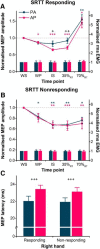Selective Suppression of Local Interneuron Circuits in Human Motor Cortex Contributes to Movement Preparation
- PMID: 29263237
- PMCID: PMC5792480
- DOI: 10.1523/JNEUROSCI.2869-17.2017
Selective Suppression of Local Interneuron Circuits in Human Motor Cortex Contributes to Movement Preparation
Abstract
Changes in neural activity occur in the motor cortex before movement, but the nature and purpose of this preparatory activity is unclear. To investigate this in the human (male and female) brain noninvasively, we used transcranial magnetic stimulation (TMS) to probe the excitability of distinct sets of excitatory inputs to corticospinal neurons during the warning period of various reaction time tasks. Using two separate methods (H-reflex conditioning and directional effects of TMS), we show that a specific set of excitatory inputs to corticospinal neurons are suppressed during motor preparation, while another set of inputs remain unaffected. To probe the behavioral relevance of this suppression, we examined whether the strength of the selective preparatory inhibition in each trial was related to reaction time. Surprisingly, the greater the amount of selective preparatory inhibition, the faster the reaction time was. This suggests that the inhibition of inputs to corticospinal neurons is not involved in preventing the release of movement but may in fact facilitate rapid reactions. Thus, selective suppression of a specific set of motor cortical neurons may be a key aspect of successful movement preparation.SIGNIFICANCE STATEMENT Movement preparation evokes substantial activity in the motor cortex despite no apparent movement. One explanation for the lack of movement is that motor cortical output in this period is gated by an inhibitory mechanism. This notion was supported by previous noninvasive TMS studies of human motor cortex indicating a reduction of corticospinal excitability. On the contrary, our data support the idea that there is a coordinated balance of activity upstream of the corticospinal output neurons. This includes a suppression of specific local circuits that supports, rather than inhibits, the rapid generation of prepared movements. Thus, the selective suppression of local circuits appears to be an essential part of successful movement preparation instead of an external control mechanism.
Keywords: corticospinal; inhibition; motor cortex; motor preparation; transcranial magnetic stimulation.
Copyright © 2018 Hannah et al.
Figures







Comment in
-
A Dynamical System Framework for Theorizing Preparatory Inhibition.J Neurosci. 2018 Apr 4;38(14):3391-3393. doi: 10.1523/JNEUROSCI.0069-18.2018. J Neurosci. 2018. PMID: 29618545 Free PMC article. No abstract available.
Similar articles
-
Changes in corticospinal excitability and the direction of evoked movements during motor preparation: a TMS study.BMC Neurosci. 2008 Jun 17;9:51. doi: 10.1186/1471-2202-9-51. BMC Neurosci. 2008. PMID: 18559096 Free PMC article.
-
Premovement Suppression of Corticospinal Excitability may be a Necessary Part of Movement Preparation.Cereb Cortex. 2020 May 14;30(5):2910-2923. doi: 10.1093/cercor/bhz283. Cereb Cortex. 2020. PMID: 31813990
-
Motor training strengthens corticospinal suppression during movement preparation.J Neurophysiol. 2020 Dec 1;124(6):1656-1666. doi: 10.1152/jn.00378.2020. Epub 2020 Sep 30. J Neurophysiol. 2020. PMID: 32997598
-
The contribution of transcranial magnetic stimulation in the functional evaluation of microcircuits in human motor cortex.Front Neural Circuits. 2013 Feb 13;7:18. doi: 10.3389/fncir.2013.00018. eCollection 2013. Front Neural Circuits. 2013. PMID: 23407686 Free PMC article. Review.
-
Transcranial magnetic stimulation: a non-invasive window into the excitatory circuits involved in human motor behavior.Exp Brain Res. 2020 Aug;238(7-8):1637-1644. doi: 10.1007/s00221-020-05803-0. Epub 2020 Apr 18. Exp Brain Res. 2020. PMID: 32306064 Review.
Cited by
-
The recruitment of indirect waves within primary motor cortex during motor imagery: A directional transcranial magnetic stimulation study.Eur J Neurosci. 2022 Dec;56(12):6187-6200. doi: 10.1111/ejn.15843. Epub 2022 Oct 18. Eur J Neurosci. 2022. PMID: 36215136 Free PMC article.
-
Modular multilevel TMS device with wide output range and ultrabrief pulse capability for sound reduction.J Neural Eng. 2022 Mar 17;19(2):10.1088/1741-2552/ac572c. doi: 10.1088/1741-2552/ac572c. J Neural Eng. 2022. PMID: 35189604 Free PMC article.
-
Cross-frequency phase-amplitude coupling in repetitive movements in patients with Parkinson's disease.J Neurophysiol. 2022 Jun 1;127(6):1606-1621. doi: 10.1152/jn.00541.2021. Epub 2022 May 11. J Neurophysiol. 2022. PMID: 35544757 Free PMC article.
-
Interactions Between Cerebellum and the Intracortical Excitatory Circuits of Motor Cortex: a Mini-Review.Cerebellum. 2022 Feb;21(1):159-166. doi: 10.1007/s12311-021-01278-z. Epub 2021 May 12. Cerebellum. 2022. PMID: 33978934 Review.
-
Intracortical facilitation and inhibition in human primary motor cortex during motor skill acquisition.Exp Brain Res. 2022 Dec;240(12):3289-3304. doi: 10.1007/s00221-022-06496-3. Epub 2022 Oct 29. Exp Brain Res. 2022. PMID: 36308563 Free PMC article.
References
-
- Day BL, Rothwell JC, Thompson PD, Maertens De Noordhout A, Nakashima K, Shannon K, Marsden CD (1989b) Delay in the execution of voluntary movement by electrical or magnetic brain stimulation in intact man: evidence for the storage of motor programs in the brain. Brain 112:649–663. 10.1093/brain/112.3.649 - DOI - PubMed
Publication types
MeSH terms
Grants and funding
LinkOut - more resources
Full Text Sources
Other Literature Sources
Medical
